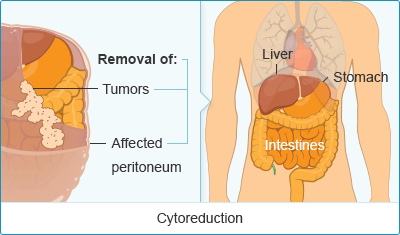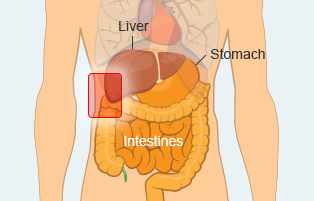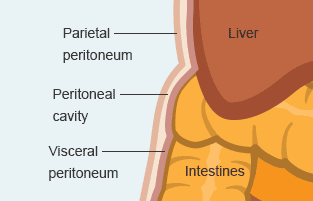Prognosis
Although there isn’t currently a cure for mesothelioma, the outlook of new research is hopeful. There have been cases of long-term survivors who have been in remission for over fifteen years. The most successful cases are those whose mesothelioma is detected in the earlier stages and treatment immediately begins. Most cases include a cytoreductive surgery and HIPEC.
Although there are similarities between pleural and peritoneal mesothelioma, the treatment options differ. The median survival time for patients who have not had the cytoreductive surgery is about a year; however, in patients who have had the surgery, survival grows up to five years.
Learn more about how mesothelioma survivors beat the odds in our free Mesothelioma Survivors Guide. Read inspiring true stories of triumph over mesothelioma.
Secondary Treament
Chemotherapy
Peritoneal mesothelioma patients in the later stages may receive chemotherapy for palliative purposes. The patients may be given the same combination as with pleural mesothelioma, pemetrexed and cisplatin. Studies are also being done on the effectiveness of the drugs vinorelbine and gemcitabine in combination with cisplatin.
A recent case in 2009 shows promise with the combination of two popular chemotherapy drugs in patients with peritoneal mesothelioma. A patient went in for an unrelated procedure and which signs of peritoneal mesothelioma were found. The patient was given the combination of permetrexed (500 mg) and cisplatin (80 mg).
After the first six cycles all signs and markers of the peritoneal mesothelioma were gone. Six months later, CT scans showed no changes or reoccurrence regarding the mesothelioma. After 4 years, the patient is alive with no signs of disease progression.
Studies show the normal survival rate of patients with peritoneal mesothelioma is around 7.6 months if they do not receive chemotherapy. Forty-one percent of patients who were given the combination experienced improvement, while 17% showed satisfactory results with cisplatin alone.
On average, patients lived 12.1 months longer when having received the combination, compared to 9.3 months on just cisplatin.
Radiation
For many peritoneal mesothelioma patients, radiation is not usually effective. It may shrink tumors before or after a cytoreduction. However, there have been no cases reported of complete eradication by solely using radiation. A mesothelioma specialist can determine if radiation is right for the patient based on their specific diagnosis.
Surgery
Cytoreduction Surgery

Cytoreduction is also referred to as “debulking.” The goal of cytoreduction is to remove as much of the tumor as possible, if not all of it. It is often not possible to remove the entire tumor. The peritoneum (lining of the abdomen) is completely removed and is usually performed in patients with stage 1 or 2 peritoneal mesothelioma.
It is also performed for other abdominal cancers, so it is performed widely. Cytoreduction recovery can take anywhere from 7 to 13 days. One study showed a majority of patients experiencing nausea up to 13 days after their surgery. Regular activities, such as eating, drinking, re-gaining bowel functions, and mobilization were re-established within 11 days after the cytoreduction and HIPEC.
Hyperthermic Intraperitoneal Chemotherapy (HIPEC)
Hyperthermic Intraperitneal Chemotherapy is also known as HIPEC treatment. HIPEC is used in patients who have cancers of the abdomen. This high dose of chemotherapy removes any remaining cancer cells left after a cytoreduction surgery. HIPEC is a heated and sterilized chemotherapy treatment.
The side effects of this chemotherapy are less than those of regularly administered chemotherapy. At the end of the 60-90 minutes, the chemotherapy is washed out of the body.
- Also referred to as “hot chemo”.
- Usually done after cytoreduction.
- Administered both during surgery (most effective) and after using an abdominal catheter.
Treatment
Treatment options are dependent on the stage a peritoneal mesothelioma patient is diagnosed with. There are more curative treatment options, like cytoreduction surgery, for patients with earlier stages. Patients in the later stages may receive palliative treatments, like radiation or chemotherapy. Another palliative treatment option may be a paracentesis to drain the fluid buildup in the abdomen.
The most successful treatment conducted has been the combination of cytoreduction surgery and HIPEC (hyperthermic intraperitoneal chemotherapy). The cytoreduction removes most of the cancerous tumor and HIPEC has been shown to kill the remaining cells.
This treatment has been relatively successful in patients with good general health. Some patients have lived as long as 7 years after having this surgery.
Find doctors who can perform this procedure using our free Doctor Match program.
Diagnosis
CT scans or MRI test results may not show the presence of mesothelioma. It may often be confused with abdominal distension (gas). X-rays are the most commonly used imaging tool to diagnose peritoneal mesothelioma.
Doctors may also use a technique called peritoneoscopy. A surgeon make a small incision on the patients abdomen and use a small camera to explore the abdomen. There is also a tool on the camera that helps to extract tissue on the peritoneum to test for mesothelioma.
Doctors do not use a standard staging system when diagnosing peritoneal mesothelioma.
Generally, in stage one, the mesothelioma is centralized in the abdomen and is more than likely able to be entirely removed. As it progresses to stage 2 the cancer may spread more but is still contained in the peritoneum. In the third stage, the cancer begins to metastasize to other organs, such as the liver and colon. In the final stage, stage 4, the mesothelioma has spread to other organs.



0 comments:
Post a Comment